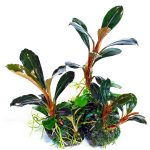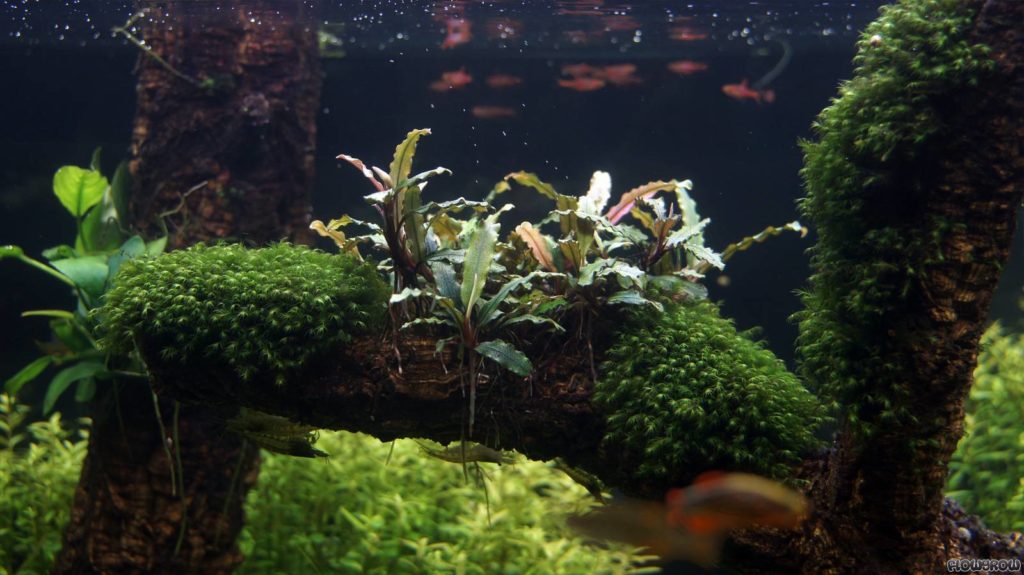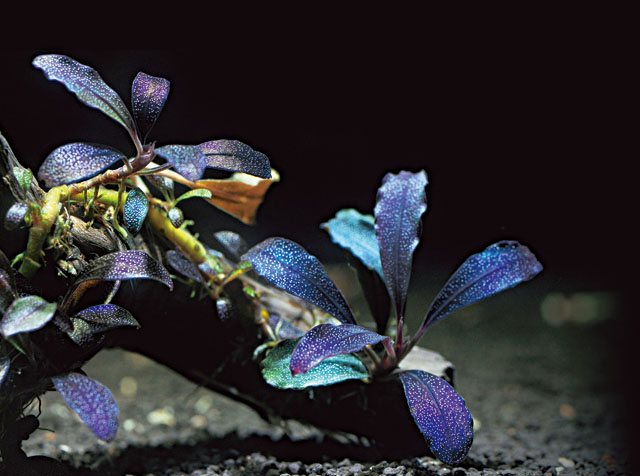Based on their appearance, Bucephalandras are similar to Anubias and Cryptocoryne. Because of their very close appearance to the Cryptocoryne species, they were introduced as their alternative when first introduced into the hobby. Their narrow and olive-colored leaves closely resemble Cryptocoryne with only a few minor differences. Their rhizomes and roots fit the characteristics of Anubias more closely. Bucephalandras can be considered a mix between these two plant species.
Check out our inventory of Bucephalandra Seeds!
Environment
Bucephalandras are adapted to life in rivers with fast moving currents. They are newly discovered plant in the aquarium hobby but they have been documented in as early as 1858. The genus name Bucephalandra refers to the name of the black horse of Alexander, Bucephalus. Bucephalandras are all endemic which means that they are known to grow only on isolated areas. This plant species can be found on many of the islands in the Malay Archipelago, also known as Borneo. More and more species of Bucephalandras are being discovered today as we explore previously hidden parts of the islands.
Bucephalandras are found in rivers and streams, and sometimes on the banks of rivers. Borneo has a tropical climate, which means that there is the same climate year-round with average annual temperatures exceeding 20 degrees Celsius. Despite the consistent climate in some areas on the island, Borneo still has two seasons that are determined by the amount of rainfall. During the rainy season when the river level rises, Bucephalandra plants growing out of water are submerged under water for a few months. However, this does not prevent them from continuing to grow and they can easily transform into their submerged forms. The main differences between submersed and emersed forms are that when they are grown under water, they have a more delicate leaf structure and they exhibit more intense coloration.
Bucephalandra Care and Growing Conditions
In aquariums, Bucephalandras can be grown on hardscapes. I will recommend growing them on hard surfaces to make advantage of their root’s ability to attach to hard surfaces, regardless of its texture. Because of their strong root growth, you sometimes need to cut your way through its roots to be able to remove them.
Bucephalandras has in the past melted by losing their leaves if the environmental conditions are inconsistent – like water chemistry and light intensity. Another thing that makes the leaves of Bucephalandras fall out is the buildup of algae and changes in fertilization concentration. Fortunately, the process is gradual so you can spot the problem long before it becomes worse. Even without leaves, if the roots are healthily attached to something, the plant will continue to live and can recover given enough time. Many aquarists suggest dimming the lights and increasing the amount of oxygen in the water should help the plant recover its health in case its leaves have already fallen.
If you decide to dim the lights for Bucephalandras, they will recover their health but their leaf colors will not be as brightly colored as it was originally. To ensure good coloration, strong lighting is required (up to 0.5W per liter). Additional fertilizing is also known to positively affect the color of the plant. To make sure that your aquarium is getting all the nutrients it requires, you can use the Estimative Index Fertilization method. This method would put enough fertilizers into your aquarium which allows them to grow healthily with brightly colored leaves.
Common Problems of Bucephalandra
Since Bucephalandras grow so slowly, algae are a common problem. Once algae are formed inside the tank, it can limit the light and slow the growth of the plant. You don’t want this to happen as stunted growth can lead to dull colors and weak health of the plant. One good thing though is that Bucephalandras are quite hardy and most types of algae can be removed by spot treating with H2O2 on the effective leaves. Typically a mixture of 1 part H2O2, 4 parts water.
Another problem is the Bucephalandras is it is slowly disappearing from the environment because of deforestation on the islands of Borneo. Many varieties are becoming harder to find and some species can only be found in captivity. While this can be considered sad news, aquarists that are collecting these plants are effectively prolonging their life on this planet. The wide scale deforestation on their island of origin doesn’t seem to slow down. Basically, there will come a time where only the collectors have this plant species. There have been many calls to stop deforestation in that region so hopefully in the future they can once again grow uninterrupted in those regions.
Appearance
What makes Bucephalandras unique is their interesting leaf shapes. The shape of their leaves is very different from other species which makes them appealing to many collectors.  Their leaves have varying shapes as well depending the particular Bucephalandra species – it can be oval, long and straight, long and wavy, round and wavy, or droplet shape. The leaf colors vary as well, from pink/red to dark violet. The leaves can be multi-colored as well depending on the species. Different species can give you most of all the colors of the rainbow.
Their leaves have varying shapes as well depending the particular Bucephalandra species – it can be oval, long and straight, long and wavy, round and wavy, or droplet shape. The leaf colors vary as well, from pink/red to dark violet. The leaves can be multi-colored as well depending on the species. Different species can give you most of all the colors of the rainbow.
Probably the most desired leaf characteristic of Bucephalandras the “blue gloss” which only appears when you look at the leaves at certain angles. Many species display this characteristic to which the most attractive is the combination of dark navy blue leaves. One of the most distinctive features of the Bucephalandras are the bright spots on the leaves which is the direct result of photosynthesis. The intensity of the spots is dependent on the species. You can also see these bright spots on Anubias but they aren’t as noticeable as the Bucephalandras. The bright spots offer great contrast especially under water.
Popular Species:
Because of their relatively new discovery, only a few Bucephalandra species have full description for them. The most popular Bucephalandra species are the brownie blue, magnifolia and motoleyana. However, more and more Bucephalandra species are being discovered today and you can even find more than 200 variations of trade names – many of which have yet to be named. Because many Bucephalandra species have yet to be named officially, they are called based on the names of the regions which they were collected (e.g. Kedagang, Tapah, Sabah, Kalimantan, Sintang, etc). Some Bucephalandra species are most known because of their prominent color (e.g. Brownie Brown, Super Blue, Dark Achilles, Green Achilles, etc).
In the aquarium hobby, Bucephalandra are fairly new and only surged in popularity as recently as 2008. Most species of Bucephalandra are very expensive because of their rarity and endemic nature. Unfortunately, you shouldn’t expect the price to go down fast because they are becoming rarer by the year due to the problem of deforestation in their place of origin. There is also a stranglehold on the market from wholesalers raising the prices once a species becomes popular in the aquatic hobby.


